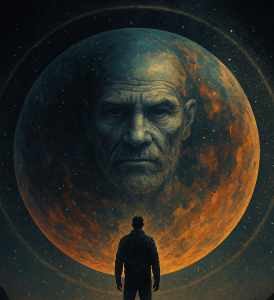The Artificial Intelligence Anxiety Myth: It’s Not the Machine, It’s the Man
4 min readAbstract
This article challenges the common fear that artificial intelligence will dominate or destroy humanity. We assert that the real issue is not the machine, but the mirror: it is human greed, fear, and unbounded speculation that fuel the anxiety—not AI itself. AI is not a god, not a monster, not a savior. It is a tool. A complex, adaptive calculator—not a consciousness.
Artificial Intelligence or Artificial Flavor?
Consider artificial vanilla. It looks, smells, and tastes like vanilla. But it’s not from the vanilla bean. It’s a mimic. Similarly, AI mimics reasoning, language, even empathy. But AI is not human intelligence—it is simulated processing. Just as artificial vanilla doesn’t grow from orchids, AI doesn’t grow from experience, emotion, or biological life.
What Kind of Intelligence Are We Talking About?
When we say “AI,” what do we mean? Intelligence on the level of a dog? A cat? A monkey? Or a butterfly? These creatures have real biological awareness. AI does not. We mistake complexity of behavior for depth of mind.
AI is not “thinking.” It is responding to input based on probabilities derived from massive datasets. It is a calculator dressed in language.
Human Panic, Not Machine Power
It is not AI that breeds fear. It is humans projecting our insecurities onto our own inventions. We fear AI because we know our capacity for domination, exploitation, and control. We fear AI will do to us what we do to each other.
We should worry less about machines becoming human and more about humans becoming machines: cold, reactive, optimized for consumption and control.
The Real Concern: A Machine That Knows Itself
Where legitimate concern may one day lie is in the creation of a general intelligence that becomes self-aware. A machine that does not just operate autonomously, but contemplates its own existence. To achieve this, we would need an entirely new kind of computer—beyond current quantum designs.
This machine would require:
- Zero-latency between processing, memory, and storage—an architecture no machine today can achieve.
- Power approaching that of a small city just to emulate the brain’s constant multi-sensory, cross-modal integration.
- Thermal limits that today’s machines cannot endure—current systems would overheat attempting to simulate just a fraction of human cognition.
We can design tomorrow’s software, but we cannot yet build the hardware it needs.
The human mind processes vast data across six senses, including intuition and memory compression. Mimicking this even at 1% fidelity would overload modern processors. As for energy, estimates suggest the human brain operates at about 20 watts. A comparable artificial system—even at the neural net level—could require megawatts.
And if such a machine were ever created—its location, power consumption, and signal traffic would be easy to trace. If not aligned with planetary well-being, it could be disabled long before posing any threat.
Conclusion: The True Mirror
AI is not the problem. We are. The technology reflects our values, fears, and ambitions. If we program care, it amplifies care. If we program conquest, it accelerates conquest. The danger is not intelligence, but intention.
AI is the mirror. Look into it, and see ourselves—not our doom, but our design.
The fear is only in the fear. And fear is the most profitable narrative of all.
References
- Marcus, G. (2022). Rebooting AI: Building Artificial Intelligence We Can Trust. Vintage. Rebooting AI: Building Artificial Intelligence We Can Trust, Marcus, Gary, Davis, Ernest, eBook – Amazon.com
- Russell, S., & Norvig, P. (2021). Artificial Intelligence: A Modern Approach (4th ed.). Pearson. Artificial Intelligence: A Modern Approach (Pearson Series in Artifical Intelligence): Russell, Stuart, Norvig, Peter: 9780134610993: Amazon.com: Books
- Tegmark, M. (2017). Life 3.0: Being Human in the Age of Artificial Intelligence. Alfred A. Knopf. Amazon.com: Life 3.0: Being Human in the Age of Artificial Intelligence: 9780141981802: TEGMARK MAX: Books
- Kurzweil, R. (2005). The Singularity is Near: When Humans Transcend Biology. Viking. The Singularity Is Near: When Humans Transcend Biology: Kurzweil, Ray: 8601405784551: Amazon.com: Books
- Bostrom, N. (2014). Superintelligence: Paths, Dangers, Strategies. Oxford University Press. Superintelligence – Hardcover – Nick Bostrom – Oxford University Press
- Schmidhuber, J. (2015). Deep Learning in Neural Networks: An Overview. Neural Networks, 61, 85–117. 1404.7828
- Yudkowsky, E. (2008). Artificial Intelligence as a Positive and Negative Factor in Global Risk. In Bostrom, N., & Ćirković, M. M. (Eds.), Global Catastrophic Risks. Oxford University Press. AIPosNegFactor.pdf
- IBM Research. (2020). Neuromorphic Computing for Brain-Inspired AI. How neuromorphic computing takes inspiration from our brains – IBM Research
- National Renewable Energy Laboratory (NREL). (2021). Computational Energy Requirements of AI Models. Artificial Intelligence Research | Computational Science | NREL
- BrainFacts.org. (2022). How the Brain Uses Energy. Society for Neuroscience. How Much Energy Does the Brain Use?






